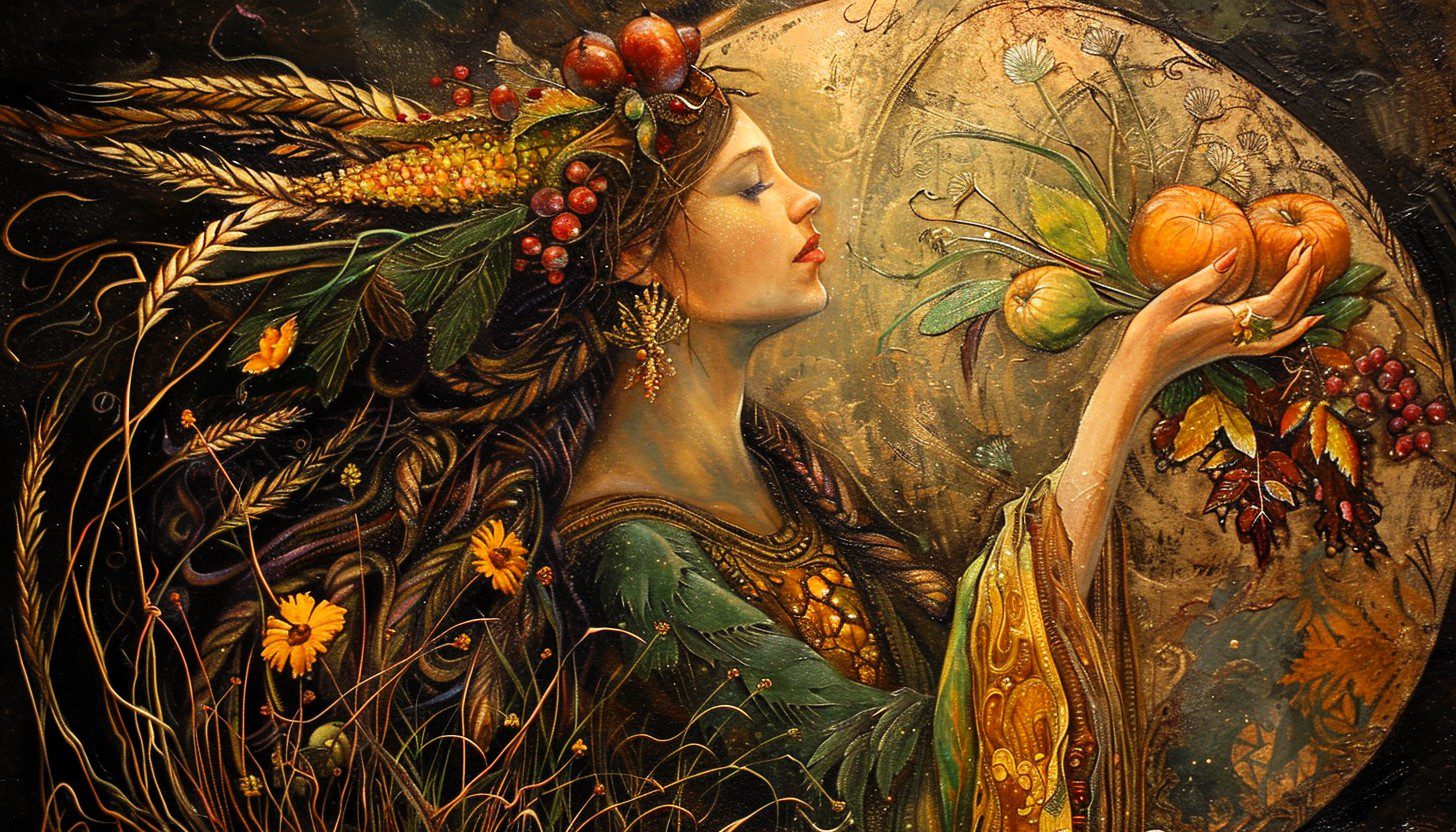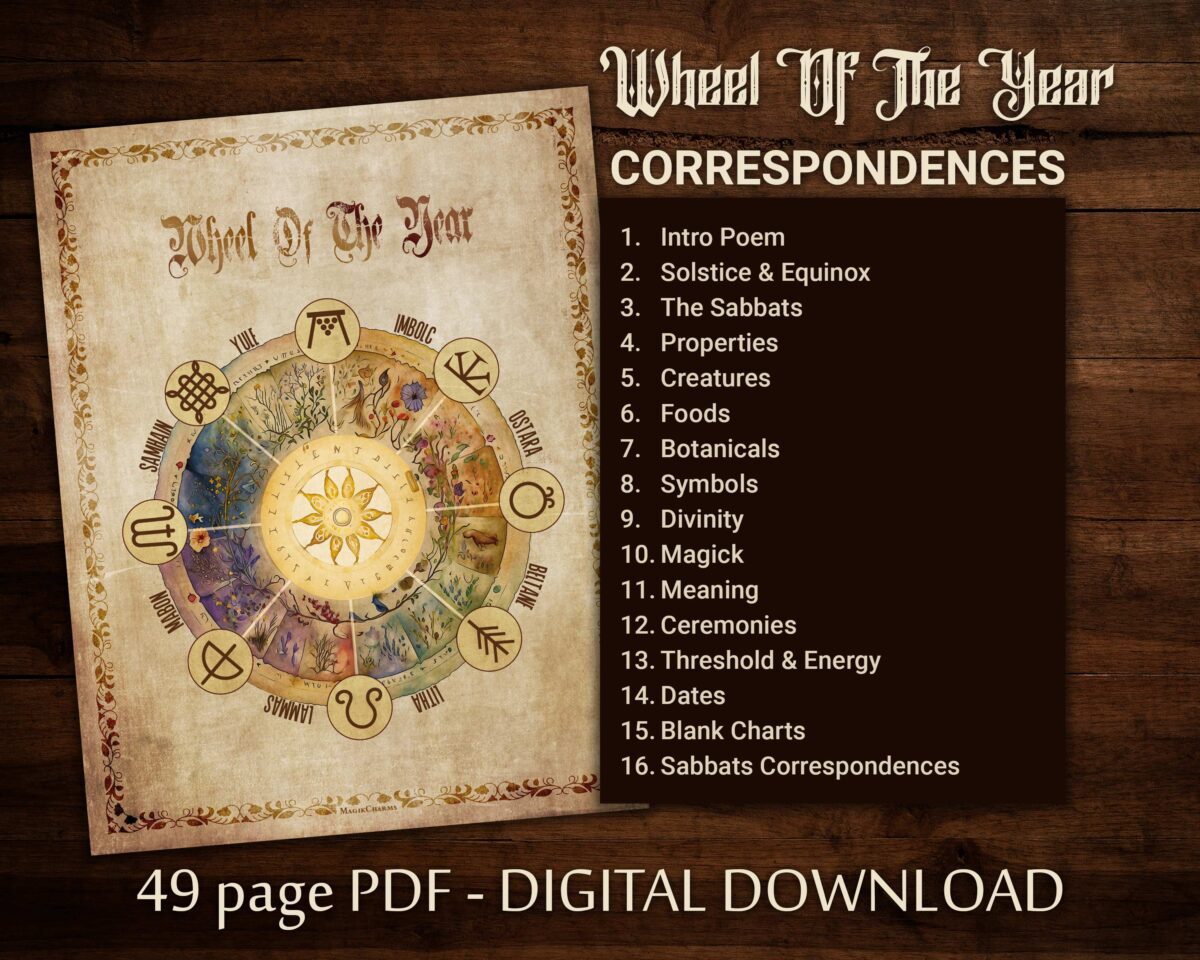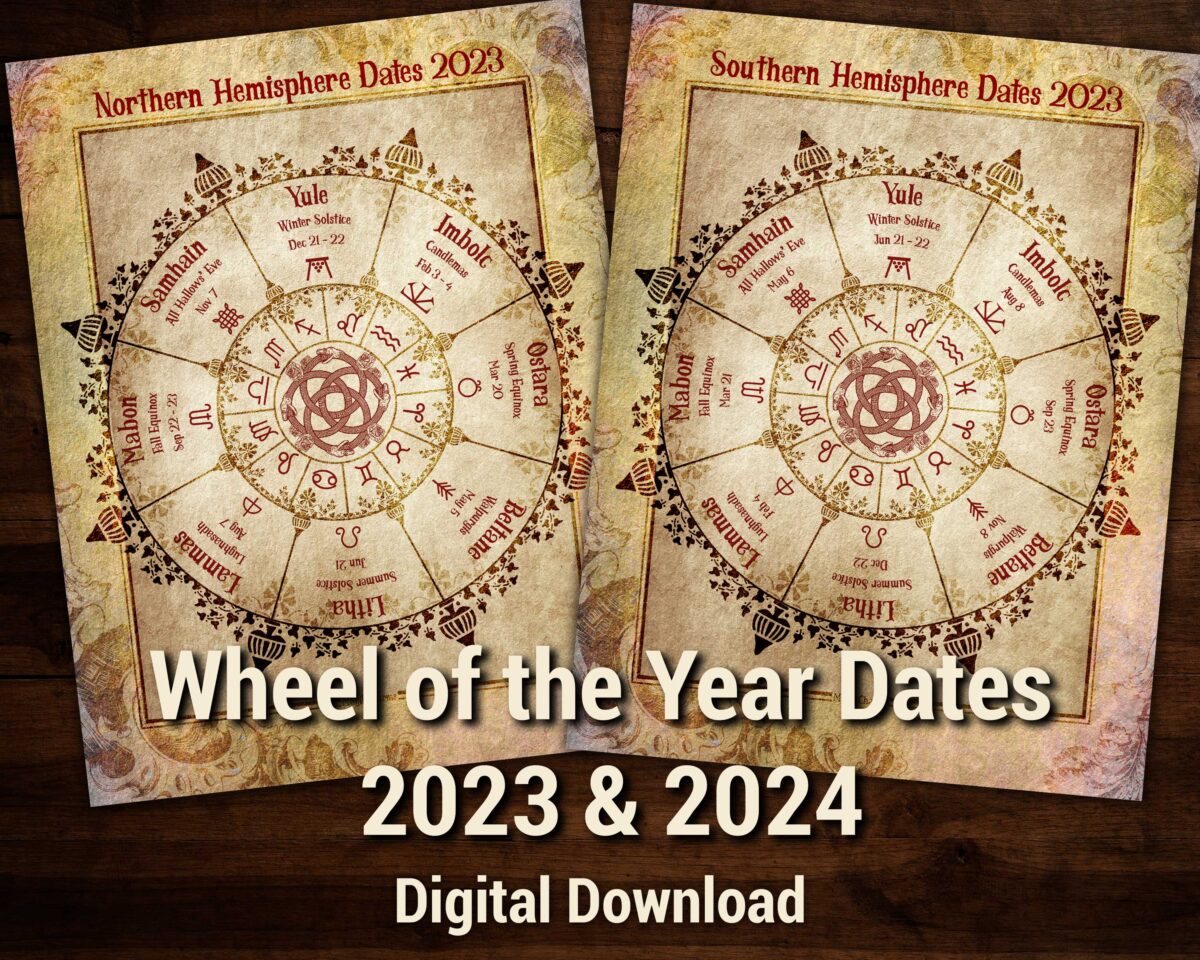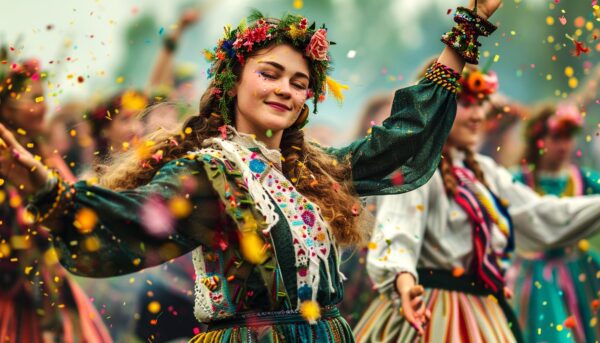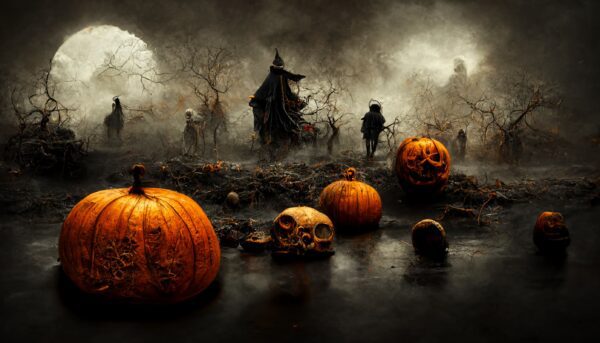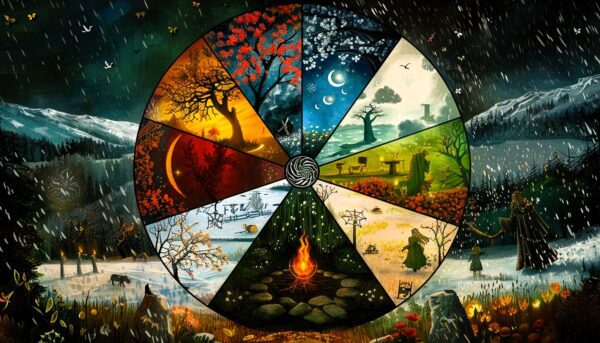- What is Lughnasadh?
- Colors, Symbols, and Deities of Lughnasadh
- Creating a Sacred Space: The Lughnasadh Altar
- Lughnasadh Celebrations: Honoring the First Harvest
- A Sample Lughnasadh Ritual
- Beyond Ritual: Embracing the Spirit of Lughnasadh
- Lughnasadh Crafts and Activities
- Lughnasadh Around the World
- Conclusion: The Bounty of Lughnasadh
Celebrate the First Harvest: Unveiling the Magick of Lughnasadh (Lammas)
As summer unfolds, a sense of accomplishment fills the air. Crops are ripening, and the first fruits of our labor are ready to be harvested. This time of abundance is celebrated in the Wiccan tradition as Lughnasadh (pronouncedLOO-na-sah), also known as Lammas.
What is Lughnasadh? Mark your calendars! Celebrated around August 1st in the Northern Hemisphere and February 1st in the Southern Hemisphere, Lughnasadh honors the first harvest, a time to express gratitude for the earth’s bounty.
Lughnasadh’s Meaning and Significance:
- First Harvest: Lughnasadh is a joyous celebration of the first harvest. It’s a time to acknowledge our hard work, give thanks for nature’s gifts, and savor the delicious fruits of our labor. Bread, baked from the newly harvested grains, takes center stage at Lughnasadh celebrations.
- Community: Lughnasadh emphasizes the importance of community. People come together to share their harvest, celebrate their achievements, and strengthen the bonds that connect them.
- Gratitude: With overflowing granaries, Lughnasadh is a time to express deep gratitude for the earth’s provision. It’s a reminder of our dependence on nature and the importance of living in harmony with it.
A Journey Through Lughnasadh’s History: Lughnasadh’s roots are firmly planted in Celtic traditions. Back then, it was a festival honoring the Celtic god Lugh, associated with agriculture, craftsmanship, and kingship. Offerings were made to Lugh to ensure a bountiful harvest and continued prosperity throughout the year.
The Rich Tapestry of Gaelic Tradition: Gaelic traditions surrounding Lughnasadh are particularly vibrant. People held games, competitions, and fairs to mark the occasion. Traditional hand-fasting ceremonies, a precursor to modern marriage, sometimes took place during Lughnasadh.
Celebrate Lughnasadh in the Modern World! While specific practices may have evolved, Lughnasadh’s core message remains. It’s a time to give thanks for the harvest, connect with your community, and appreciate the beauty and abundance of the natural world. In the following sections, we’ll delve deeper into the traditions, symbols, and ways to celebrate Lughnasadh in a modern context. Get ready to savor the spirit of the first harvest!
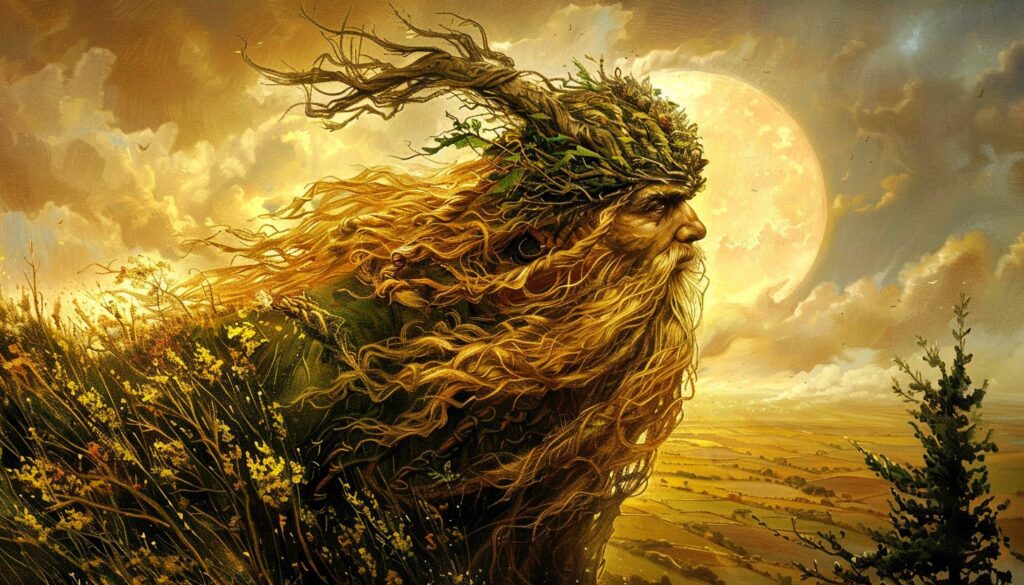


Unveiling the Colors, Symbols, and Deities of Lughnasadh: Celebrating the First Harvest
Lughnasadh, a vibrant festival marking the first harvest, bursts with colors, symbols, and deities that celebrate the earth’s bounty and the fruits of our labor. Let’s delve into the rich tapestry of this agricultural festival.
Lughnasadh’s Palette: A Celebration of Abundance
- Gold: Reminiscent of ripe grains and the golden hues of summer, gold represents the harvest’s bounty, prosperity, and the sun’s continued blessings. Decorate with gold cloths, wear gold jewelry, or light gold candles to express gratitude for the earth’s gifts.
- Brown: The color of fertile soil and freshly baked bread, brown embodies the foundation of the harvest and the nourishment it provides. Decorate with brown cloths, wear brown clothing, or use brown candles to connect with the earth and the cycle of growth.
- Earthy Greens and Reds: Reflecting the vibrant colors of summer produce, these colors represent the abundance and life force present in the harvest. Decorate with vegetables and fruits in these colors, wear earthy green or red clothing, or use these colored candles to celebrate the season’s offerings.
Lughnasadh’s Symbolic Language: A Bountiful Harvest
- Bread: The centerpiece of Lughnasadh celebrations, bread represents the transformation of grain into life-sustaining food. Baking bread from the new harvest is a traditional way to express gratitude and share the bounty with loved ones.
- Cornucopia: A horn overflowing with fruits and vegetables, the cornucopia symbolizes abundance, prosperity, and the generosity of the earth. It can be used as a decoration, a centerpiece for the harvest feast, or a symbol in rituals.
- Grains: Barley, wheat, oats – these grains are the foundation of the harvest and represent sustenance, hard work, and the cycle of planting, reaping, and giving thanks. They can be incorporated into rituals, displayed as decorations, or used in baking traditional harvest breads.
- Agricultural Tools: Sickles, scythes, and baskets – these tools represent the labor and skill involved in bringing in the harvest. They serve as a reminder of the effort put into cultivating the land and the importance of honoring the process.
Deities of Lughnasadh: Invoking Gratitude for the Harvest
- Lugh (Celtic): This prominent Celtic god, associated with crafts, kingship, and agriculture, is a central figure in Lughnasadh celebrations. He’s seen as the embodiment of the harvest’s success and the skills needed to achieve it.
- Ceres (Roman): The Roman goddess of agriculture, grain crops, fertility, and motherhood, resonates with the themes of Lughnasadh. She represents the nurturing aspects of the harvest and the cycle of life and growth.
- Demeter (Greek): Demeter, the Greek goddess of agriculture, harvest, and sacred law, is another deity connected to Lughnasadh. Her myth of searching for her daughter Persephone reflects the cycle of the seasons and the importance of the harvest.
- Arianrhod (Celtic): The Welsh goddess Arianrhod, associated with fertility, the moon, and rebirth, also finds connections to Lughnasadh. She represents the cyclical nature of life, the transformation of seeds into harvest, and the promise of future abundance.
By incorporating these colors, symbols, and deities into your Lughnasadh celebrations, you connect with the spirit of the first harvest, express gratitude for the earth’s bounty, and celebrate the fruits of your labor.
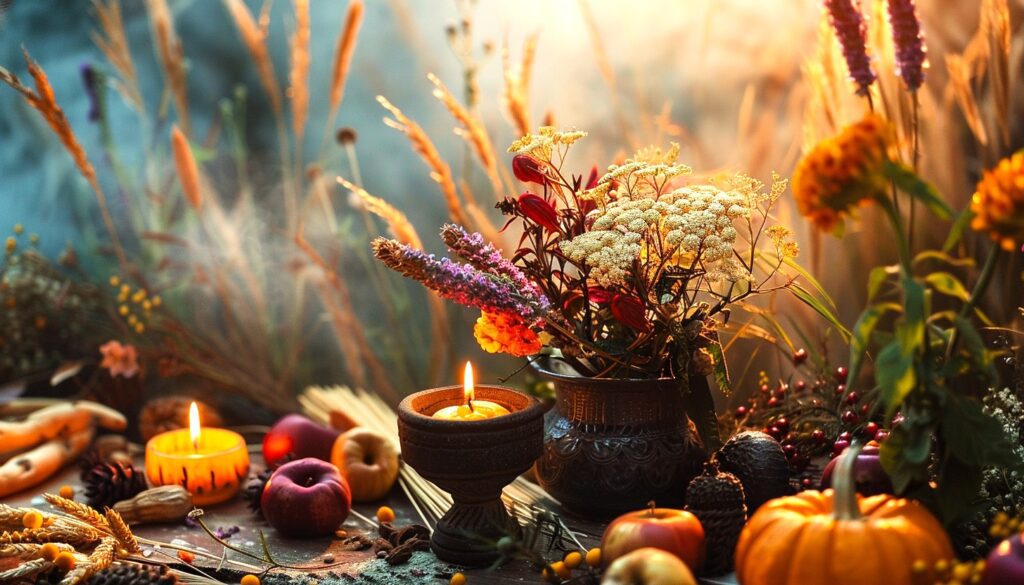


Celebrate the Harvest: Crafting Your Lughnasadh Altar
Lughnasadh, the first harvest festival, overflows with gratitude for the earth’s bounty. To honor this time of reaping and celebration, create a sacred space on your altar that reflects the season’s richness. Let’s explore how to craft a Lughnasadh altar brimming with gratitude.
Set Your Lughnasadh Intention
Lughnasadh celebrates the first harvest, craftsmanship, and community. What aspects of these themes resonate with you? Do you wish to express gratitude for abundance, welcome new projects, or strengthen connections with loved ones? Choose an intention that reflects the harvest’s bounty and let it guide your altar’s creation.
Essential Elements for a Lughnasadh Altar
- Colored Cloths: Opt for earthy tones! Gold represents the harvest’s bounty, while brown embodies the fertile soil. You can also use a combination of both for a grounded and abundant display.
- Candles: Pillar candles are ideal for Lughnasadh. Choose gold, brown, or white candles to mirror your intention. White candles can also symbolize new beginnings or honoring ancestors.
- Bowls: Fill a bowl with fresh water, symbolizing life-giving energy. Another bowl can hold offerings to deities or be used for displaying grains or seeds from the harvest.
- Harvest Symbols: Lughnasadh is all about the harvest! Include a cornucopia overflowing with fruits and vegetables (real or decorative) or a loaf of bread baked from the first harvest grains.
Embrace the Earth’s Bounty
Lughnasadh is a time to connect with the earth’s generosity. Decorate your altar with natural elements that showcase the season’s harvest. Scatter colorful dried beans, lentils, or peas to represent abundance. Include a small sheaf of wheat or barley to symbolize the fruits of one’s labor.
Fruits of Your Labor
Make your Lughnasadh altar truly special by incorporating elements from your own harvest. If you have fresh fruits or vegetables from your garden, display them proudly. A small jar of homemade jam or a loaf of bread you baked yourself adds a personal touch and reflects the season’s spirit.
As you craft your Lughnasadh altar, feel the gratitude for the earth’s bounty fill your space. This sacred space becomes a beacon for expressing thanks, celebrating community, and honoring the first harvest’s richness. Let the season’s abundance inspire your intentions and guide you through Lughnasadh’s joyful celebration.
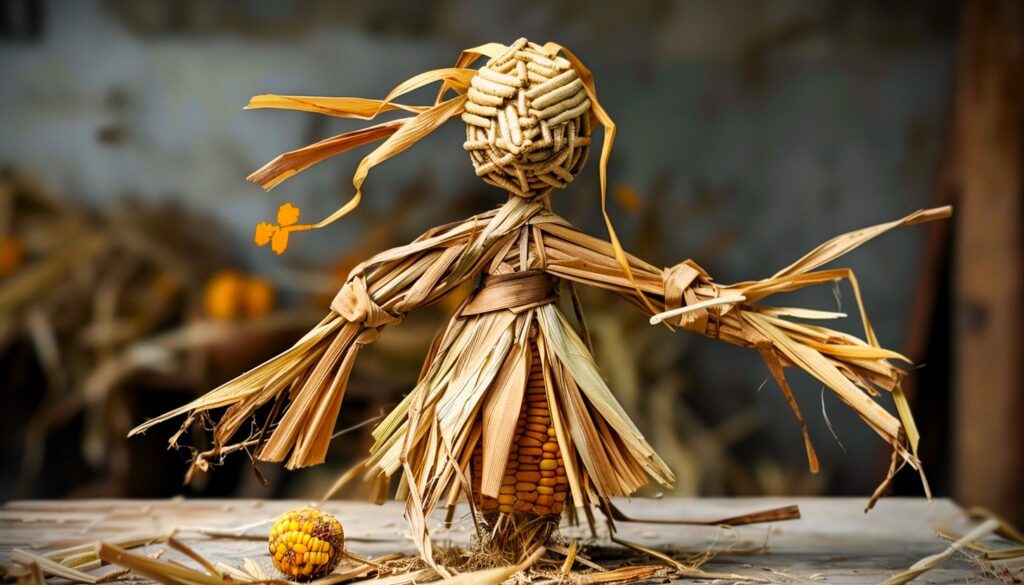


Lughnasadh Bounty: Celebrating the First Harvest!
Lughnasadh, arriving around August 1st, marks the beginning of the harvest season. It’s a joyous festival overflowing with gratitude for the earth’s bounty, delicious food, and traditional activities. Here’s how you can embrace the spirit of Lughnasadh and celebrate the first harvest:
Harvest Festivals and Feasts: Sharing the Abundance
Lughnasadh is a time for community gatherings and feasting. Celebrate with loved ones and express thanks for the harvest:
- Symbolic Foods: Incorporate symbolic foods into your feast. Bread, baked from the first harvest grains, represents the fruits of labor. Fruits and vegetables showcase the earth’s bounty, while nuts symbolize potential for future harvests.
- Community Potlucks: Organize a potluck with friends and neighbors. Everyone brings a dish made with fresh, seasonal ingredients, creating a vibrant and delicious feast to share.
Bread Baking Rituals: Honoring the Harvest Grain
Baking bread from the first harvest grains is a symbolic and nourishing tradition during Lughnasadh:
- Significance of the Offering: The first loaf of bread is often seen as an offering to deities or a way to honor the earth’s gift. Share the bread with loved ones or enjoy it with a grateful heart.
- Harvest Bread Recipes: Find online recipes for traditional harvest breads. Many cultures have unique bread recipes associated with Lughnasadh, often incorporating grains like wheat, barley, or oats with honey, nuts, or seeds.
Corn Dollies and Crafts: Bringing the Harvest to Life
Corn dollies, figures woven from straw or wheat stalks, are a traditional Lughnasadh craft symbolizing fertility and the harvest spirit:
- Symbols of Fertility: Corn dollies were often placed in fields or hung in homes to ensure a bountiful harvest in the coming year. Today, they can be a fun and creative way to connect with the harvest spirit.
- Get Crafty!: Explore online tutorials or use your imagination to create your own corn dollies or other harvest-themed crafts using straw, grains, and dried flowers.
Games and Competitions: Celebrating with Merriment
Lughnasadh was traditionally a time for playful competitions and games celebrating strength, skill, and the joy of harvest:
- Archery Contests: In some cultures, archery contests were held during Lughnasadh, symbolizing hunting prowess and آمادگی (amaadigi, Arabic for “readiness”) for winter.
- Dancing and Merriment: Organize traditional dances or simply enjoy playful games with friends and family. Laughter and merriment are a core part of Lughnasadh celebrations.
Gratitude Rituals: Giving Thanks for the Earth’s Gifts
Lughnasadh is a perfect time to express gratitude for the harvest and the earth’s generosity:
- Offerings: Leave a small offering of fruits, vegetables, or grains outside as a symbolic gesture of thanks to the earth.
- Journaling: Reflect on your blessings and the importance of the harvest in a gratitude journal. Write down what you’re thankful for and the lessons learned throughout the growing season.
- Meditation: Find a quiet space and practice a meditation focused on gratitude. Visualize the earth’s bounty and the interconnectedness of all living things.
Lughnasadh is a vibrant celebration overflowing with gratitude, delicious food, and traditions that connect us to the harvest cycle. Embrace the spirit of the season, share the bounty with loved ones, and express your appreciation for the earth’s gifts.
Celebrating the First Harvest: A Sample Lughnasadh Ritual
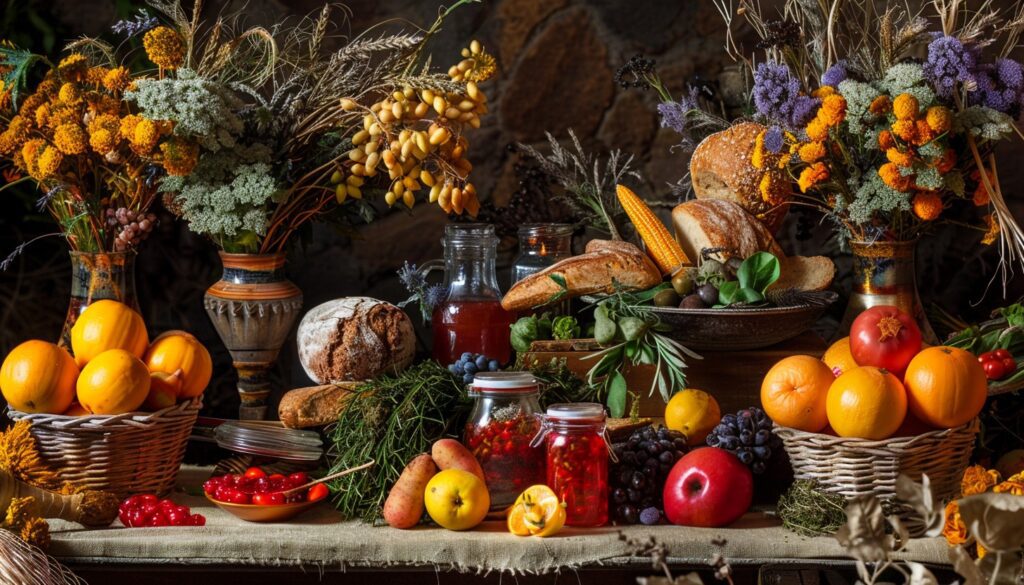


Setting the Scene:
Gather outdoors in a pleasant space, or indoors near a window with natural light. Decorate your altar with a golden cloth, symbolizing the bounty of the harvest. Include stalks of wheat, colorful seasonal fruits, and objects associated with craftsmanship and creativity (tools, paints, etc.). Light a white candle in the center to represent the waning summer sun.
Opening the Ceremony:
Cast a circle around your space using a method you feel comfortable with (visualizing white light, playing calming music, etc.). Light the white candle on your altar. Begin by acknowledging the original inhabitants of the land you’re on, if you feel comfortable doing so (optional: “We acknowledge the [original people] who stewarded this land before us”). Call upon the spirits of Lughnasadh, the energy of the harvest, and the creativity of the God Lugh:
“As the summer sun wanes and the first harvest arrives, we gather to celebrate Lughnasadh. Welcome, spirits of abundance and craftsmanship!”
Offering of First Fruits:
Hold a small basket filled with freshly harvested grains or fruits. Express gratitude for the earth’s bounty and offer them symbolically to the ground or a designated offering bowl. Visualize the harvest nourishing you and the community throughout the coming year.
Bread Baking Ritual:
(This can be done individually or as a group activity) If baking bread, prepare dough together, focusing on the act of creation and the transformation of grains into sustenance. As you knead the dough, visualize your hopes and desires for abundance in the coming year. Bake the bread and enjoy its warm aroma, a symbol of Lughnasadh’s blessings.
Sharing the Harvest Feast:
Gather around a shared meal featuring the bounty of the first harvest. Enjoy fresh vegetables, fruits, and grains, along with any bread you baked. Express gratitude for the earth’s blessings and the joy of community.
Simple Prosperity Spell:
Hold a few grains of wheat or a small piece of fruit in your hands and close your eyes. Focus on your desires for abundance and blessings in the coming year. Clearly state your intentions out loud. Visualize the grains or fruit glowing with golden light, infusing them with your desires. Carry them with you as a reminder of your intentions and a symbol of future prosperity.
Closing the Ceremony:
Thank the spirits of Lughnasadh and the harvest for their presence. Gently release the circle you cast. Take a grounding moment, feeling your connection to the earth and the satisfaction of the first harvest. Open your eyes, feeling grateful and hopeful for the year ahead.
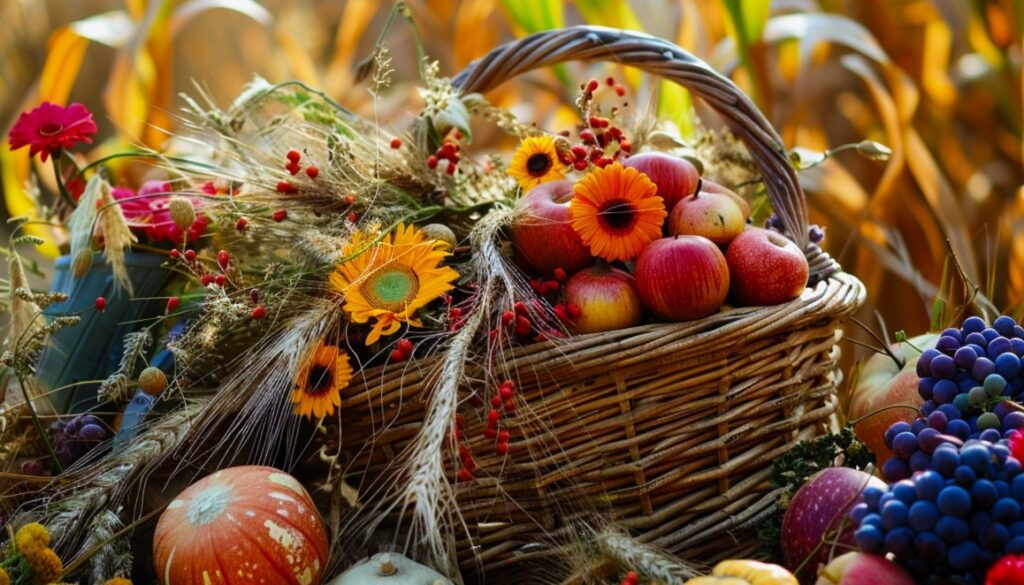


Lughnasadh’s Bounty: Embracing the Harvest Beyond Ritual
Lughnasadh, the first harvest festival, celebrates the earth’s bounty and the fruits of our labor. It’s a season of sharing, creativity, and preparing for the changing seasons. While rituals can be a meaningful way to connect with Lughnasadh’s spirit, the true magick unfolds in your daily life. Here’s how to embrace Lughnasadh’s energy beyond the ceremonial gathering:
Overflowing with Gratitude:
Lughnasadh is a time to express overflowing gratitude for the harvest and the earth’s abundance. Savor the taste of fresh fruits and vegetables, appreciate the beauty of golden grains, and acknowledge the effort that went into cultivating these gifts. Keep a gratitude journal, cook a meal with homegrown ingredients, or simply take a moment each day to appreciate the bounty that surrounds you.
Celebrating with Loved Ones:
Lughnasadh is a celebration best shared with loved ones. Host a potluck featuring the harvest’s bounty, share stories and laughter around a bonfire, or volunteer at a community food bank. Giving back and strengthening community connections are beautiful ways to honor the spirit of Lughnasadh.
Honing Your Harvest Crafts:
Lughnasadh ignites a passion for craftsmanship and practical skills. Learn a new skill related to the harvest, such as baking bread, preserving fruits, or creating decorative crafts with dried flowers and grains. Developing these skills allows you to connect more deeply with the harvest and express your creativity.
Embracing Self-Sufficiency:
Lughnasadh encourages us to reflect on self-sufficiency and living in harmony with nature. Consider planting a small herb garden, learning basic food preservation techniques, or exploring local farmers markets. By taking steps towards self-sufficiency, you honor the spirit of the harvest and connect with the natural world that sustains us.
Preparing for the Coming Season:
Lughnasadh marks the subtle shift towards fall. Take time to prepare your home and garden for the changing seasons. Organize your pantry to store harvested goods, mend clothes for cooler weather, or simply reflect on your goals for the upcoming months. Acknowledging the transition allows for a smoother shift into fall and fosters a sense of preparedness.
By incorporating these practices, you can extend the spirit of Lughnasadh beyond the harvest festival. Let it inspire gratitude for the earth’s bounty, strengthen your community bonds, and encourage you to develop new skills. Embrace self-sufficiency and prepare for the changing seasons as you savor the beauty and lessons of Lughnasadh.
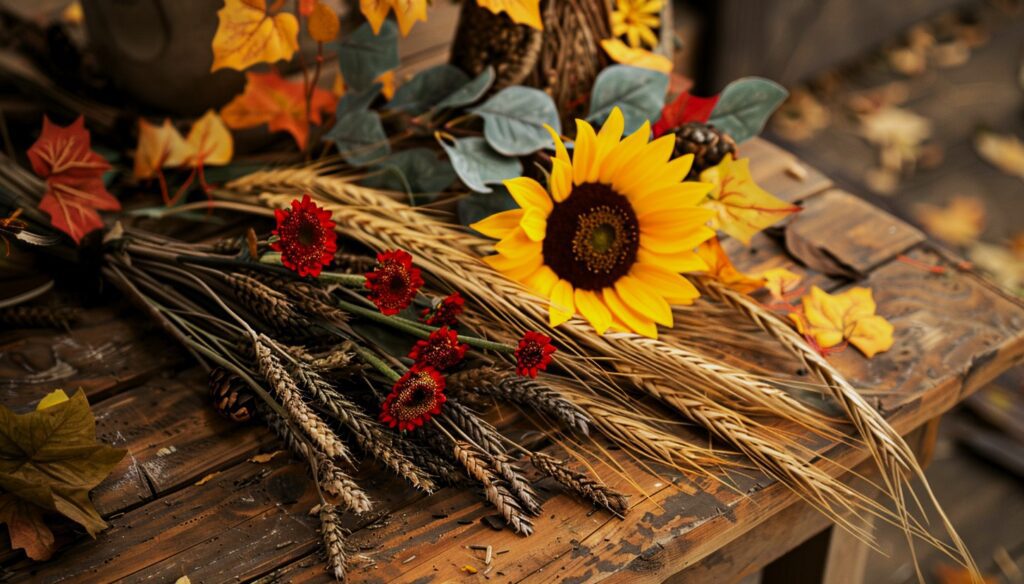


Lughnasadh Fun: Celebrate the Harvest with Crafts & Activities!
Lughnasadh, the first harvest festival, is a time to give thanks for nature’s bounty! Here are some delightful activities to connect your kids with the spirit of the season:
Crafting with the Harvest:
- Corn Dolly Delight: Weave a traditional corn dolly from colorful husks! This symbol of the harvest can be displayed in your home or gifted to loved ones.
- Bread Baking Fun: Get your hands messy and bake delicious bread from scratch! Let your child help knead the dough and decorate loaves with seeds or grains.
Soothing Scents of Autumn:
Lughnasadh herbs offer a touch of magick! Fill small fabric squares with calming herbs like lavender or chamomile. Sew them shut to create soothing dream pillows that help your child drift off to peaceful sleep.
Lughnasadh Crafts for Little Hands:
- Harvest Baskets: Braid colorful yarn or strips of fabric to create beautiful baskets perfect for holding autumn treasures collected on walks.
- Sunflowers & Grains: Decorate your home with the colors of the harvest! Use sunflowers, dried wheat stalks, and colorful leaves to create vibrant centerpieces or decorate doorways.
- Gratitude Journals: Help your child create a gratitude journal decorated with harvest symbols. Encourage them to write down things they’re thankful for each day, fostering a spirit of appreciation.
Let these activities spark your child’s creativity, connect them with the magick of the harvest, and celebrate the abundance of Lughnasadh!
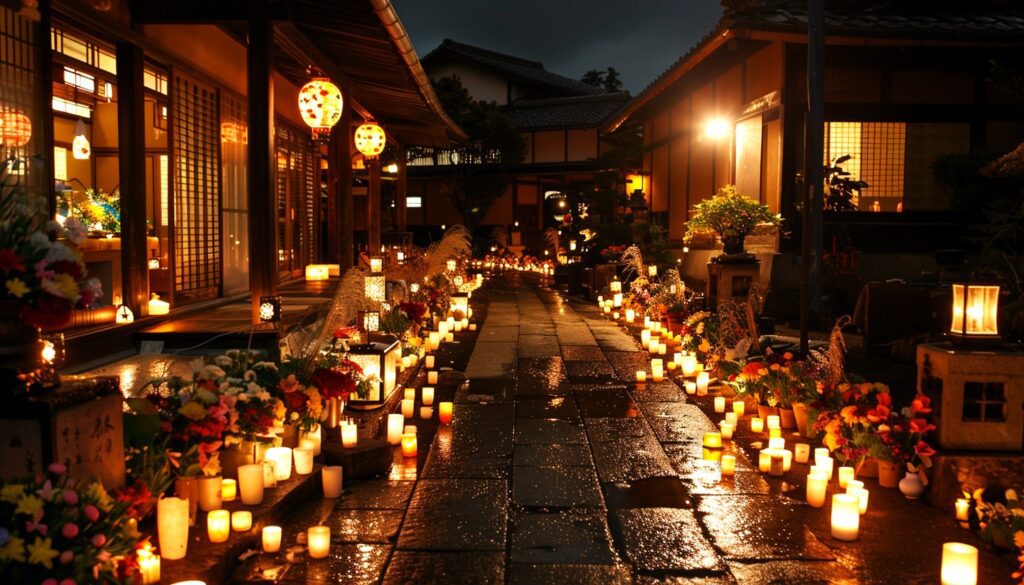


Lughnasadh’s Global Bounty: Celebrating the First Harvest Around the World
Lughnasadh, the first harvest festival, is a time to give thanks for nature’s bounty. But the spirit of giving thanks and celebrating the fruits of our labor transcends borders! Let’s explore how cultures worldwide embrace the essence of Lughnasadh with their unique traditions:
Obon: Honoring Ancestors in Japan:
During Obon, a beautiful Japanese festival observed in mid-August, families welcome and honor the spirits of deceased ancestors. Elaborate altars are decorated with offerings of food and flowers. Bonfires are lit to guide ancestral spirits home, and families visit cemeteries to clean and decorate ancestral graves. Obon is a time for both remembrance and joyful celebration, with traditional dances, music, and festive lanterns illuminating the night sky.
Feast of Diana: Roman Tribute to the Huntress:
The ancient Romans celebrated Lughnasadh with the Feast of Diana, honoring Diana, the goddess of the hunt, the wild, and the harvest. Held in mid-August, the festival involved offerings of grain and fruit to Diana, as well as celebratory games and competitions. Hunters would give thanks for their skills and pray for a successful hunting season in the coming months.
Carioca: Brazilian Harvest Revelry:
In Brazil, Lughnasadh finds its vibrant expression in the Carioca festival. Held in Rio de Janeiro, Carioca is a week-long celebration of harvest, music, and dance. Streets come alive with colorful parades featuring samba dancers and musicians. Traditional foods like feijoada (a hearty black bean stew) and pão de queijo (cheese bread) are enjoyed by all. The festival is a joyous expression of gratitude for the harvest and a celebration of Brazilian culture.
From Japanese ancestral reverence to Roman offerings and Brazilian dance, Lughnasadh’s global influence is undeniable. As you celebrate the first harvest, remember that you’re part of a worldwide tapestry of cultures giving thanks for nature’s bounty and the fruits of our collective efforts.
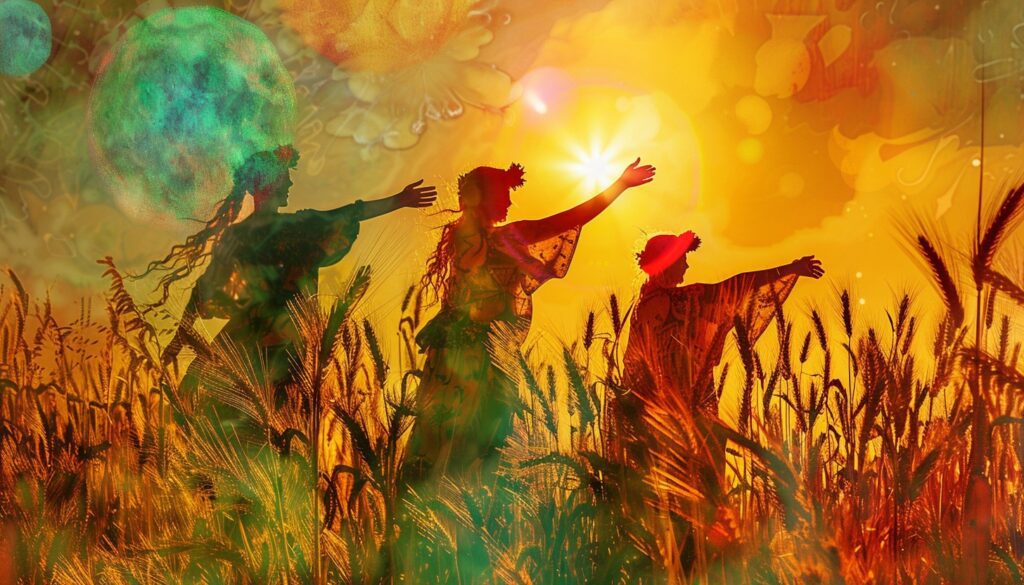


Lughnasadh’s Golden Harvest: A Celebration of Gratitude and Community
Lughnasadh, the first harvest festival, marks a time to gather, give thanks, and celebrate the bounty of the earth. It’s a season of community, sharing, and honoring the fruits of our collective labor.
Gratitude Fills the Air:
Lughnasadh is a reminder to appreciate the earth’s blessings. Through offerings, feasts, and shared meals, we express gratitude for a successful harvest and the nourishment it provides.
Abundance Overflows:
Fields yield their bounty, orchards overflow with ripe fruits, and gardens burst with vibrant colors. Lughnasadh reminds us of nature’s generosity and the importance of living in harmony with the land.
Community Spirit Thrives:
Lughnasadh is a time to connect with our communities. Traditional gatherings, shared meals, and collaborative harvest efforts reinforce the importance of working together and sharing the fruits of our labor.
Celebrate Lughnasadh’s Spirit:
There are many ways to connect with Lughnasadh’s spirit. Bake a bread from fresh harvest grains, create a community harvest festival potluck, or simply take a walk and appreciate the abundance around you.
Embrace the Harvest Spirit:
Lughnasadh reminds us to slow down, savor the season’s bounty, and appreciate the interconnectedness of our communities. Let the spirit of harvest inspire you to share your blessings and celebrate the joy of giving thanks.
Celebrate Lughnasadh in whatever way feels most meaningful to you. Embrace the spirit of community, express gratitude for the earth’s gifts, and step forward with a heart full of abundance.

